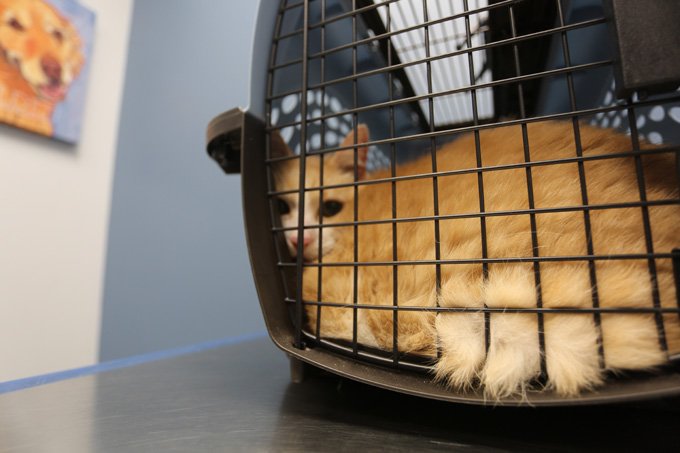This article courtesy of PetMD.com.
Rabies is an inflammatory infection that specifically affects the gray matter of the cat’s brain and its central nervous system (CNS). The primary way the rabies virus is transmitted to cats in the United States is through a bite from a disease carrier: foxes, raccoons, skunks, and bats. Infectious virus particles are retained in a rabid animal’s salivary glands to better disseminate the virus through their saliva.
Once the virus enters the cat’s body, it replicates in the cells of the muscles and then spreads to the closest nerve fibers, including all peripheral, sensory and motor nerves, traveling from there to the CNS via fluid within the nerves. The virus can take up to a month to develop, but once the symptoms have begun, the virus progresses rapidly.
This severe, and often fatal, viral polioencephalitis also has zoonotic characteristics, and can therefore be transmitted to humans. If you would like to learn more about how this disease affects dogs, please visit this page in the PetMD health library.
Symptoms and Types
There are two forms of rabies: paralytic and furious. In the early symptom (prodomal) stage of rabies infection, the cat will show only mild signs of CNS abnormalities. This stage will last from one to three days. Most cats will then progress to either the furious stage, the paralytic stage, or a combination of the two, while others succumb to the infection without displaying any major symptoms.
Furious rabies is characterized by extreme behavioral changes, including overt aggression and attack behavior. Paralytic rabies, also referred to as dumb rabies, is characterized by weakness and loss of coordination in the cat, followed by paralysis.
This is a fast-moving virus. If it is not treated soon after the symptoms have begun, the prognosis is poor. Therefore, if your cat has been in a fight with another animal, or has been bitten or scratched by another animal, or if you have any reason to suspect that your pet has come into contact with a rabid animal (even if your pet has been vaccinated against the virus), you must take your cat to a veterinarian for preventive care immediately.
The following are some other symptoms to watch for in your cat:
- Pica
- Fever
- Seizures
- Paralysis
- Hydrophobia
- Jaw is dropped
- Inability to swallow
- Muscular lack of coordination
- Unusual shyness or aggression
- Excessive excitability
- Constant irritability/changes in attitude and behavior
- Paralysis in the mandible and larynx
- Excessive, dripping salivation (hypersalivation), or frothy saliva
Causes
The rabies virus is a single-stranded RNA virus of the genus Lyssavirus, which is in the family Rhabdoviridae. It is transmitted through the exchange of blood or saliva from an infected animal, and very rarely through breathing in the escaping gases from decomposing animal carcasses. Contracting the virus in this way is rare but it can occur, often in caves with a large population of bats, where the virus is widespread.
Diagnosis
If you suspect your cat has rabies, call your veterinarian immediately. If it is safe to do so, cage, or otherwise subdue your cat, and take it to a veterinarian to be quarantined. If your pet is behaving viciously, or is trying to attack, and you feel you are at risk of being bitten or scratched, you must contact animal control to catch your cat for you.
Your veterinarian will keep your cat quarantined in a locked cage for 10 days. This is the only acceptable method for confirming suspected rabies infection.
Rabies can be confused with other conditions that cause aggressive behavior, so a laboratory blood analysis must be conducted to confirm the presence of the virus. However, blood testing for the virus is not veterinary procedure.
Diagnosis in the U.S. is done using a post-mortem direct fluorescence antibody test performed by a state-approved laboratory for rabies diagnosis. Your veterinarian will collect fluid samples if your cat dies while in quarantine, or if it begins showing progressive signs of rabies; in which case, your veterinarian will opt to put your cat to sleep (or euthanize it).
Treatment
If your cat has been vaccinated against rabies, provide proof of vaccination to your veterinarian. If anyone came into contact with the cat’s saliva, or were bitten by your cat (yourself included), advise them to contact a physician immediately for treatment. Unfortunately, rabies is always fatal for unvaccinated animals, usually occurring within 7 to 10 days from when the initial symptoms began.
If a diagnosis of rabies is confirmed you will need to report the case to your local health department. An unvaccinated cat that is bitten or exposed to a known rabid animal must be quarantined for up to six months, or according to local and state regulations. A vaccinated animal that has bitten or scratched a human, conversely, should be quarantined and monitored for 10 days.
Living and Management
Disinfect any area the animal might have infected (especially with saliva) using a 1:32 dilution (4 ounces to a gallon) of household bleach solution to quickly inactivate the virus. Do not allow yourself to come into contact with your cat’s saliva.
If your cat has swallowed an object, do not reach into its mouth without taking precautions. Saliva can enter into your skin through an accidental scratch, putting you at risk of contracting the virus.
This article originally appeared here on PetMD.com.









